The Noctua NH-U12S Redux Cooler Review: Bringing Noctua's Best To a Lower Price
by E. Fylladitakis on August 25, 2021 8:00 AM ESTTesting Results, Maximum Fan Speed (12 Volts)
Starting things off, let's take a look at the NH-U12S Redux performance with the fans at their full speed (12 V).

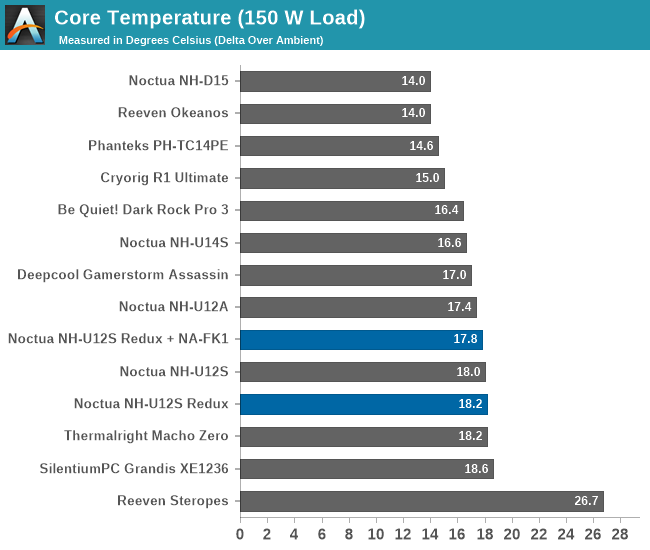
| Core Temperature, Constant Thermal Load (Max Fan Speed) |
Noctua claims that the NH-U12S Redux can perform just as well as the more advanced (and expensive) NH-U12S, just at the expense of higher noise. Our thermal testing reveals that this claim is true, as the NH-U12S Redux does perform almost identically compared to the NH-U12S. The thermal performance of the NH-U12S Redux is just a little worse than the NH-U12S without the addition of the extra NA-FK1 fan. Adding the NA-FK1 fan makes the NH-U12S Redux a little bit better than the NH-U12S but the actual performance difference is very small.
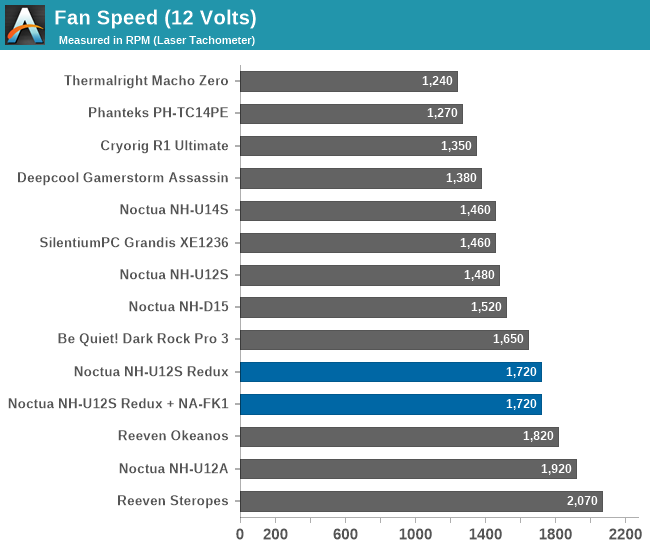
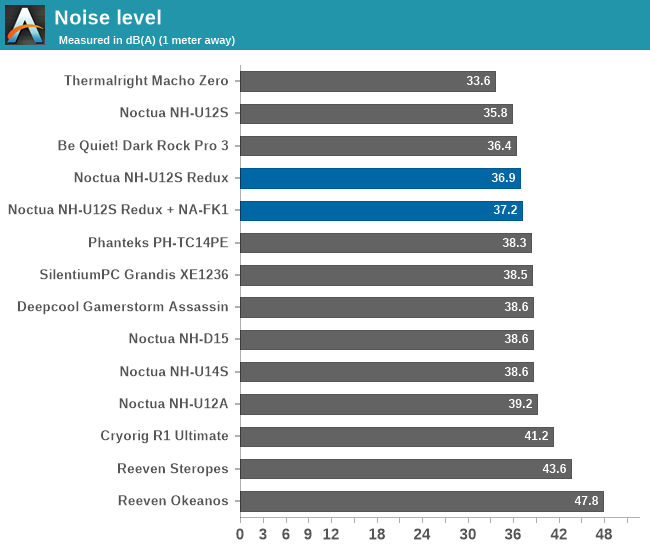
When it comes to acoustics, Noctua’s statement regarding the amount of noise generated by the NH-U12S Redux is also true. The NH-U12S Redux is noticeably louder than the NH-U12S – though not by much. With its fan running at maximum speed, the noise output of the cooler is not too high at all. Meanwhile, adding the second fan increases the noise output of the NH-U12S Redux a bit more.
Testing Results, Low Fan Speed (7 Volts)
Switching things up a bit, let's next take a look at cooler performance with the NH-U12S Redux fans taken down to 7 Volts.

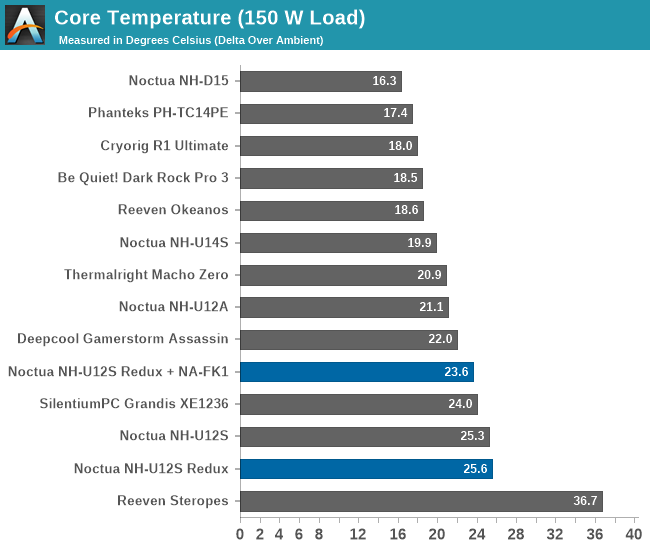
| Core Temperature, Constant Thermal Load (Low Fan Speed) |
With the speed of its fans reduced down to about 620 RPM, the NH-U12S Redux still performs almost just as well as the NH-U12S. The addition of the NA-FK1 fan here does make a difference, improving the thermal performance of the NH-U12S Redux significantly and pushing it close to the significantly larger NH-U12A.
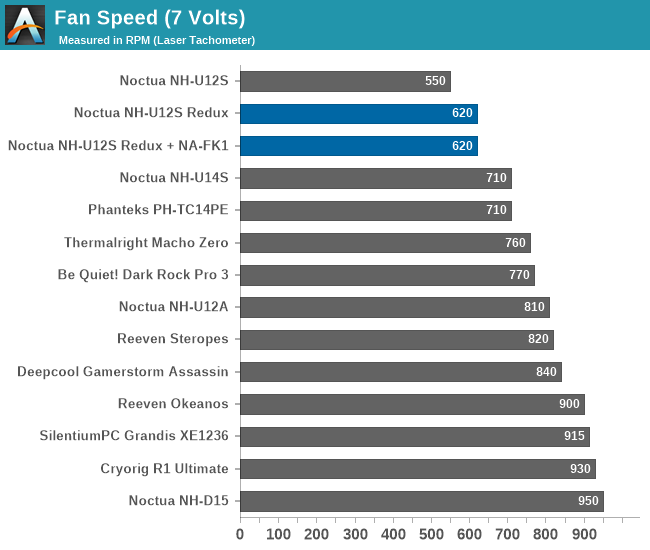
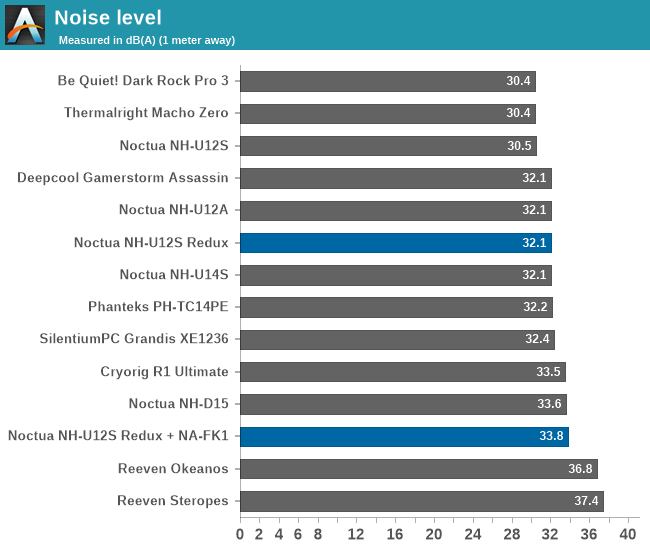
Both the NH-U12S Redux and the vanilla NH-U12S are practically dead silent under these operating conditions. The NH-U12S Redux has a noise output 1.6 dB(A) higher than that of the NH-U12S, which is technically a significant difference due to the logarithmic scale, yet on an absolute basis, 32.1 dB(A) is very low and you'd really need to focus to notice that kind of noise in a quiet room. The addition of the second fan makes the NH-U12S Redux more noticeable, but 33.8 dB(A) are very comfortable for everyday use.
Thermal Resistance VS Sound Pressure Level
During our thermal resistance vs. sound pressure level test, we maintain a steady 100W thermal load and assess the overall performance of the coolers by taking multiple temperature and sound pressure level readings within the operating range of the stock cooling fans. The result is a graph that depicts the absolute thermal resistance of the cooler in comparison to the noise generated. For both the sound pressure level and absolute thermal resistance readings, lower figures are better.
In the above chart, we can discern that the NH-U12S is indeed better than the NH-U12S Redux when both the thermal performance and acoustics are taken into account. The NH-U12S Redux does offer great overall performance though, rivaling even that of the NH-U12A under certain conditions where the fan of the latter becomes too noisy for the thermal performance the cooler offers. We can also see that the addition of the second fan makes the NH-U12S Redux capable of reaching slightly lower thermal resistance figures, though always at the disproportionate expense of noise.


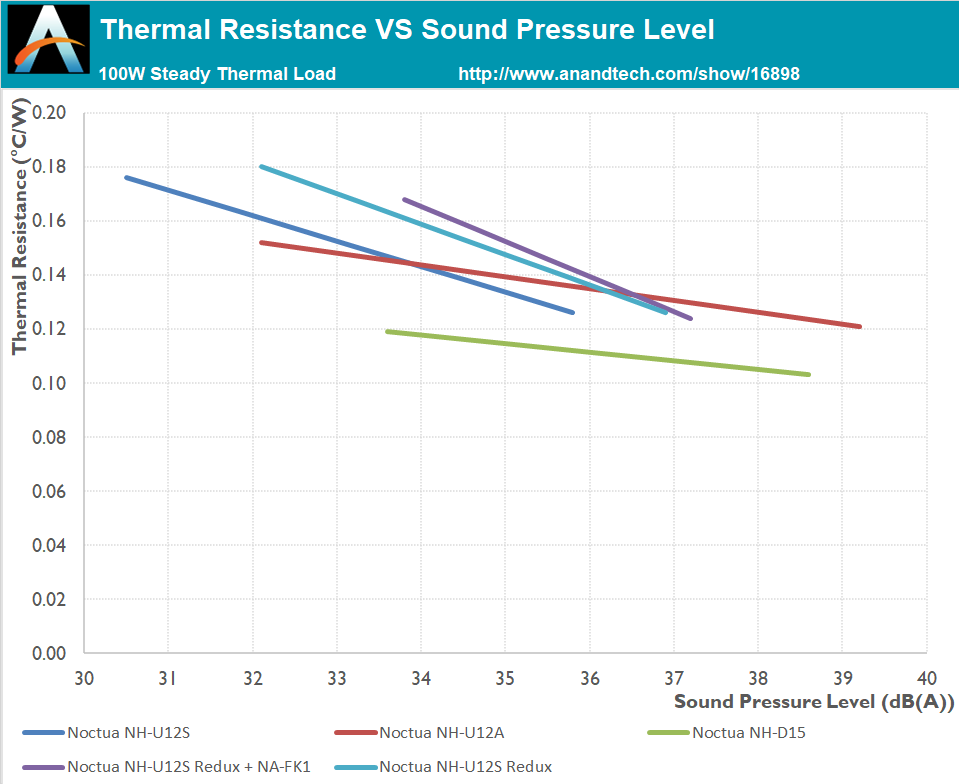








38 Comments
View All Comments
jordanclock - Wednesday, August 25, 2021 - link
I've always wondered why CPU cooler reviews don't include stock coolers.Ian Cutress - Wednesday, August 25, 2021 - link
https://www.anandtech.com/show/10500/stock-cooler-...jordanclock - Wednesday, August 25, 2021 - link
It would be nice to have at least a couple of those in this reviews graphs, but jumping between them shows that pretty much every cooler in this review performs much better than a stock cooler, and the worst cooler here is slightly better than the AMD Wraith cooler. I'm guessing the Wraith Prism would be a bit better than that for cooling but everything I found elsewhere suggests that the Prism is not much of an improvement over the (regular?) Wraith.sonny73n - Thursday, August 26, 2021 - link
I spent extra $10 for that stupid over-hyped Wraith Spire. After 2 days putting up with its poor heat dissipation I got the NH-U12S Chromemax Black. Cost me $70 but it's well worth.Does anyone want the useless Wraith? I'm giving it away or it'll go to the trash soon.
Sivar - Thursday, August 26, 2021 - link
I used a Wraith while I waited my NH-D15 socket adapter to arrive.It performed pretty well. The Noctua only gave me a few degrees C.
One difference is that I used aftermarket head sink paste. Perhaps stock paste or overly thick paste is the issue?
MDD1963 - Sunday, August 29, 2021 - link
If an NH-D15 only netted a loss of a few degrees C , you must have had one hot running and/or overvolted CPU...(some 5000 series Ryzens run a tad warm, to be sure, although this seems semi-normal)Spunjji - Friday, August 27, 2021 - link
Any extra context on that? Which CPU were you using it with, was it stock paste, and was it the noise that bothered you or the temperatures?sonny73n - Saturday, August 28, 2021 - link
I've never used stock pastes. It took me more than 15 minutes to clean it off. I've tried both Arctic Silver 5 and MX-4 but they didn't help much with the stock cooler on my non-overclocked 3600x. The NH-U12S took about 10C down with MX-4 paste and it's quieter on high speed.Wraith Spire
Prime 95 max at 84C. Gaming max at 76C.
NH-U12S
Prime95 max at 77C. Gaming max at 65C.
Tams80 - Saturday, August 28, 2021 - link
Something sounds wrong there.But anyway, you paid an extra $60. Of course you got a better cooler.
AntonErtl - Thursday, August 26, 2021 - link
We use the Wraith Prism with a 3900X, and it performs surprisingly well. The board apparently does not power-limit the CPU, and putting load in the CPU resulted in 190W above idle power, which the Prism managed to cool. We have temperature-limited the CPU to 70C, now power is only 135W over idle after some time. Cooling this much to such a low temperature is impressive; elsewhere I always read about high temps on the 7nm Ryzens. But the Prism makes a lot of noise for this performance, so I would not use it for a deskside machine.